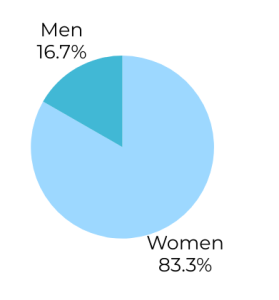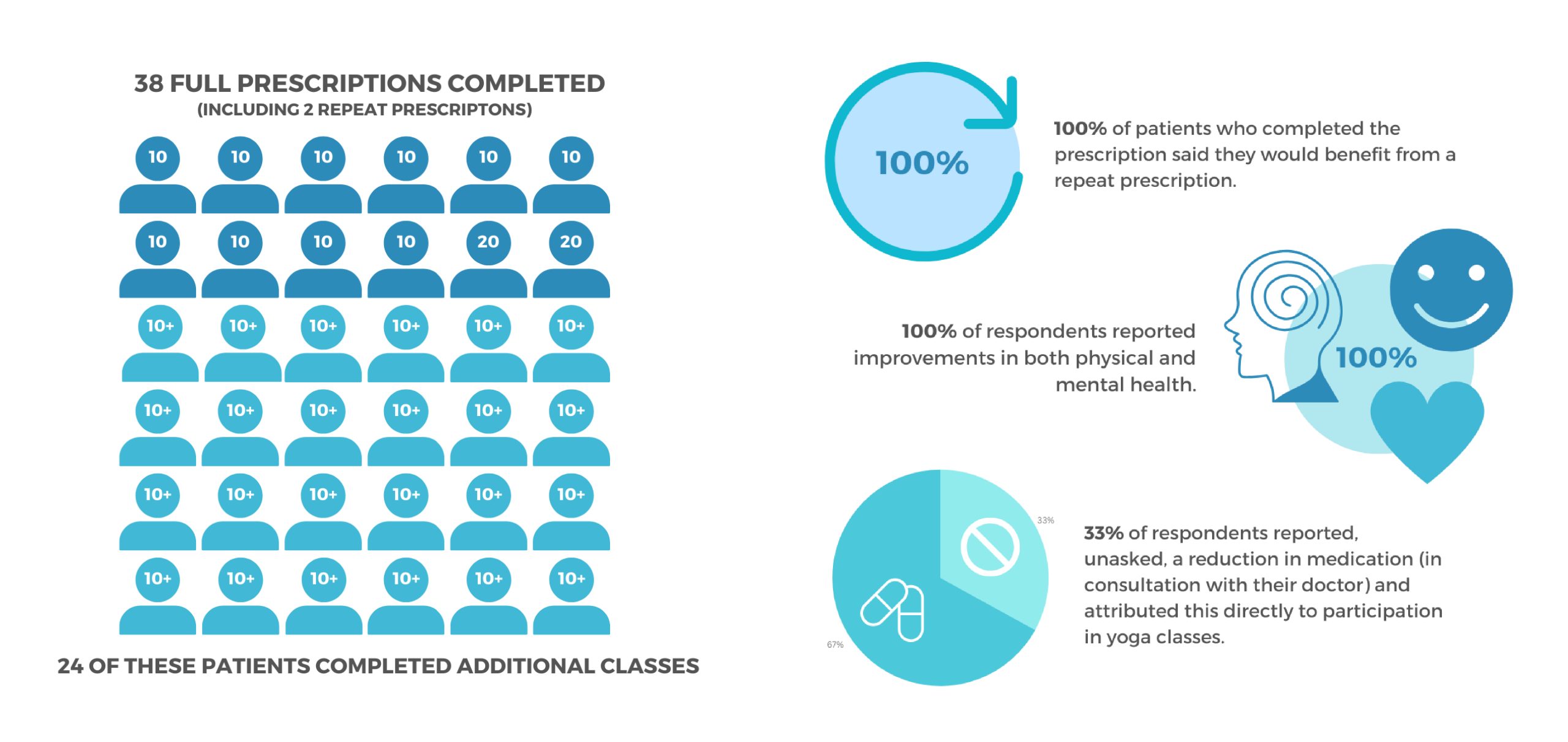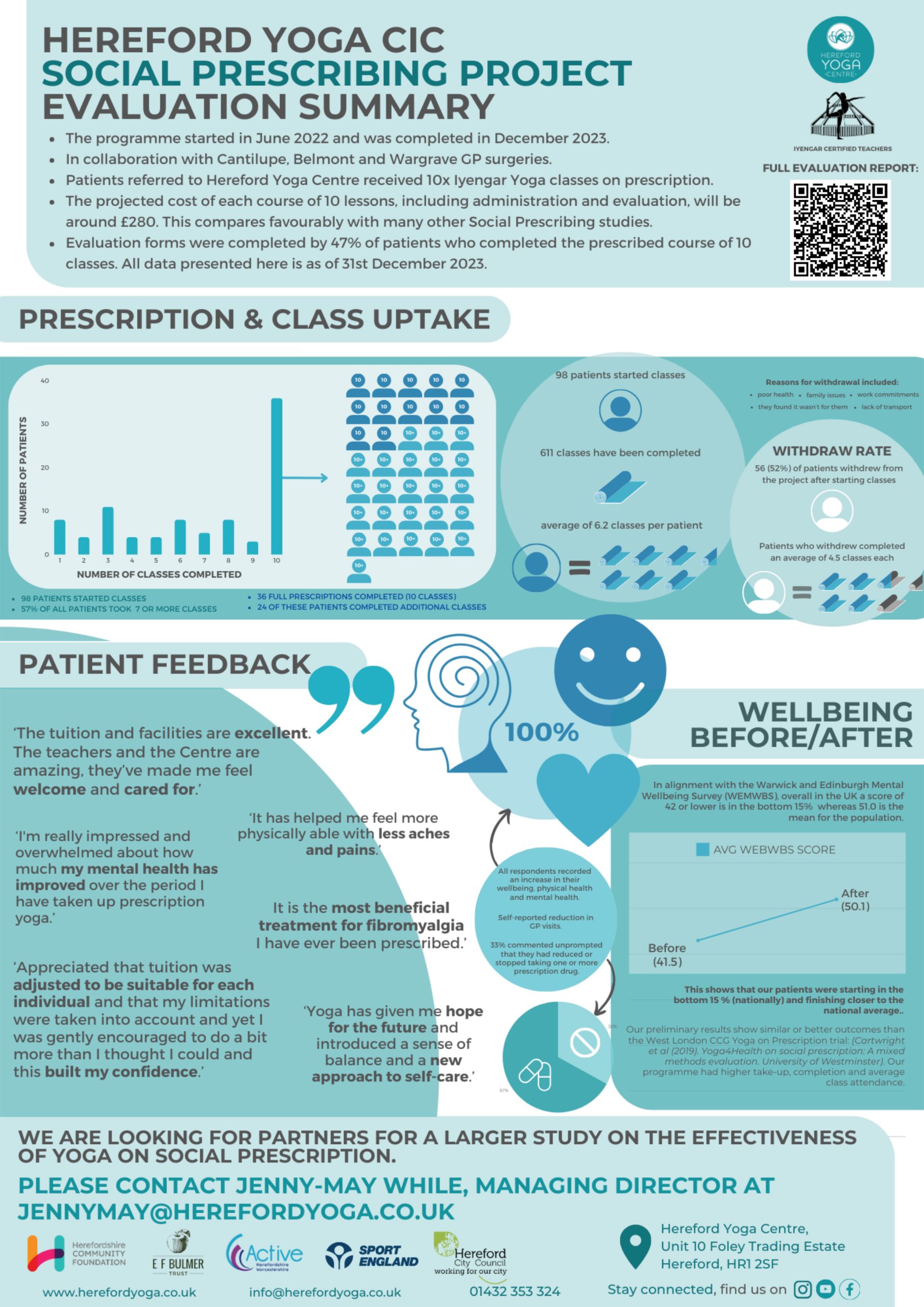Why should Iyengar yoga be available for patients on prescription?
The UK is in the grip of a mental health epidemic, with 1 in 6 people having experienced a common mental health problem (such as depression, anxiety and stress) in the last week and at an estimated annual cost of around £105 billion [1] to the UK economy. When people visit their GP with problems including mild to severe depression and anxiety, chronic pain and complex symptoms associated with isolation and loneliness, many are offered SSRI anti-depressants, opioid painkillers, or a combination of both. The prescription of antidepressants has risen by 35% in the last 6 years [2] . These medications have their place, and when used responsibly can offer some short-term relief en route to more sustainable healing processes. But long-term use is proven to produce, in some cases severely life-altering, side-effects and to be addictive [3]. And for many people, they don’t even work.
Yoga is formally recommended by the NHS, and by the WHO as ‘a valuable tool to increase physical activity and decrease noncommunicable disease’[4]. It feels obvious to those of us who have direct experience of the transformative effects of a regular practice that yoga should be on the table as a powerful and cost-effective method for both preventing and treating a range of conditions. But there is a big gap between our experience as yoga practitioners and the understanding of the medical establishment that devises how healthcare is formulated and distributed. This is partly because yoga is a completely unregulated sector; so GPs are often unable to differentiate between practices that offer patients a truly self-educative experience, and those that sell unsubstantiated images and concepts, often for financial profit. Iyengar yoga practitioners can help with that, because we know that what we do is the real deal.
The NHS is on its knees, and as usual it is those with least who are losing most- we know that ‘50% of people in the most deprived areas report poor health by age 55–59, over two decades earlier than those in the least deprived areas’.
The vast majority of GPs are of course doing a super job. But surgeries are fire-fighting; desperate to help their patients with increasingly scant resources. The NHS is on its knees, and as usual it is those with least who are losing most- we know that ‘50% of people in the most deprived areas report poor health by age 55–59, over two decades earlier than those in the least deprived areas’[5]. So why add an extra option for doctors and patients in a system that is already struggling? Because yoga, taught in groups and open to everyone, is a brilliantly effective way of empowering patients to improve and maintain their own health and wellbeing, and of reducing health inequalities. Yoga presented as a prescription by a trusted health practitioner gives those who have previously been excluded the opportunity to try it out. If it suits them, they are likely to experience some transformative changes in outlook and lifestyle that will have sometimes dramatically positive implications for their future health and happiness and reduce stress on statutory health and care services. It’s win-win; the individual and the system working together so that more people are more healthy, and precious medical resources can be redirected to the major interventions they are really needed for.
Iyengar Yoga on Prescription- a case study

In Hereford, we piloted a project offering Iyengar yoga on prescription in partnership with 3 local GP surgeries. We wanted to demonstrate how attendance in classes would both benefit patients and reduce stress on primary care services. As a CIC (community-focused non-profit) we raised £21500 to cover costs, from a range of national and local charitable funders. The funding covered project management and administration, the production of x2 educational/orientation videos (one for prescribers, one for patients), communications, 70 prescriptions of 10 Iyengar yoga classes and project evaluation/reporting. Our team of volunteer company directors helped with a range of tasks including high-level project planning, financial reporting and graphic design. Patients received a prescription from their doctor for 10 classes. Our social prescribing administrator took health details and booked them in for a first class. Patients were asked to complete a standardised wellbeing self-assessment before starting classes. They were also offered the support of a ‘buddy’; an existing student to meet, greet and help them with orientation. An important aspect of the project was that patients integrated into existing classes; we did not run patient-specific classes, but do have a range of classes on offer including for those with reduced mobility and single-gender sessions. Once the 10 classes were complete, patients filled in a wellbeing self-assessment and feedback form. Due to over-subscription to the project, we were unable to offer repeat prescriptions, but patients were offered £5 off classes to post-prescription. Unused classes (from those who dropped out) were recycled into the programme.
Introduction and information given to patients prescribers ahead of their participation:
Here are some highlights from the outcomes (view the full report HERE or scroll to the bottom for an illustrated overview):
- 98 prescriptions taken up
- 611 classes completed
- 6.2 classes per patient average
- Those who dropped out cited reasons including work and family pressures and acute health problems
- 38 courses of 10 classes completed
 66.7% of patients who completed continued classes post-subscription- others reported using free home-learning tools
66.7% of patients who completed continued classes post-subscription- others reported using free home-learning tools- 83.3% women, 16.7% men
- 100% who completed said they would benefit from a repeat prescription
- 100% who completed reported increase in wellbeing (average scores ‘before’ 42.8, ‘after’ 51.7. National average is 51.0)
- 100% of respondents reported improvement in both physical and mental health
- 33% of respondents reported, unasked, a reduction in medication (in consultation with their doctor) and attributed this directly to participation in yoga classes
- Several respondents reported a reduction in GP visits, but this project did not have the scope to make calculations based on their primary care history and projection
 Qualitative feedback demonstrated a range of benefits experienced, including:
Qualitative feedback demonstrated a range of benefits experienced, including:
- Significant improvements in mental health including reduced need for medication
- Significant pain reduction including reduced need for medication
- Significant improvements in mobility including reduced reliance on mobility aids
- Increased confidence
- Reduction in symptoms of specific conditions including fibromyalgia and plantir fasciitis
- Better sleep
- A sense of community and feeling supported
- An expression of developing choices for a healthier lifestyle
- A significant appreciation of clarity of instruction, personalised adjustments and sense of care given
View a video of our Patient Feedback HERE
What now?
In Hereford, we are looking for further funding to roll the project out so that access would be available via all surgeries across the city. But it’s difficult. There is a lot of talk about early intervention and prevention in health and social care, but very little cash to back it up. However, if we agree and can demonstrate, as an IY community, that the benefits of regular Iyengar yoga practice are real and tangible, and that everybody deserves a chance to try it for themselves, then why not place access to classes at the heart of integrated care systems across the country? It’s a bold and ambitious suggestion, but one that I believe is possible.
Developing partnerships with health services and community organisations, learning how to present the positive outcomes of regular Iyengar yoga practice for individuals and communities in ways that are relatable and replicable, and lobbying local statutory service providers to invest in Iyengar yoga is one way of beginning to make our yoga communities more meaningfully inclusive. We are hopeful here that this project is the start of something- a small seedling in the forest of radical change that is so urgently necessary to enable a socially and environmentally sustainable future, which still has a slim but real chance of emerging.
View our proposal for Phase 2 HERE

[1] https://www.mentalhealth.org.uk/explore-mental-health/mental-health-statistics/cost-diagnosed-mental-health-conditions-statistics
[2] https://pharmaceutical-journal.com/article/news/antidepressant-prescribing-increases-by-35-in-six-years#:~:text=According%20to%20the%20latest%20population,antidepressant%20drugs%20in%202021%2F2022.
[3] https://www.bristol.ac.uk/primaryhealthcare/news/2022/adverse-health-outcomes-associated-with-long-term-antidepressant-use.html
[4] https://www.who.int/southeastasia/news/detail/20-06-2018-yoga-is-a-valuable-tool-to-increase-physical-activity-and-decrease-noncommunicable-disease
[5] https://www.health.org.uk/evidence-hub/health-inequalities



Comments are closed.